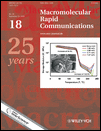Amphiphilic Block Copolymer Micelles: New Dispersant for Single Wall Carbon Nanotubes†
Supporting information for this article is available at the bottom of the article's abstract page, which can be accessed from the journal's homepage at http://www.mrc-journal.de, or from the author.
Abstract
Summary: This manuscript describes a new simple method to disperse single wall carbon nanotubes (SWNTs) in various organic solvents. The method is based on using amphiphilic block copolymer micelles as a dispersant. We have found that the stabilization of SWNTs by block copolymer micelles adhering to the surface of nanotubes is much superior to that by either surfactants or high-molecular-weight polymers currently used. Our nondestructive method is beneficial because the amphiphilic property of the block copolymer micelles enables us to stabilize SWNTs in either polar solvents or nonpolar ones at the same time. We also demonstrate that silver nanoparticles are selectively synthesized in polar cores of micelles adsorbed on the surface of SWNTs and the subsequent heat treatment modifies the surface of SWNTs.





